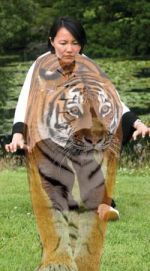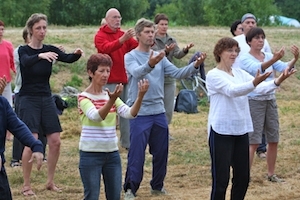Qigong (Chi Kung) – A Comprehensive Overview
10,000 Qigong methods
The Map
The Roots and Traditions of Qigong
The Roots Legendary or ancient – Historic – Contemporary
The Tradition
Fitness and Health
Medical Qigong
Daoist Qigong
Buddhist Qigong
Martial Qigong
The Body in Qigong
Dynamic, Form and Focus in Qigong
The Dynamic of Qigong Quiescent – Dynamic – Vigorous
The Form
Spontaneous or Formless Qigong
The Focus
Internal Qigong – Neigong
External Qigong – Waigong
Qi Transmission Healing
Also recommended on Qigong
“Can you calm your mind from it’s wandering and sense the unity of the ONE?
Can you can you cultivate your life force and sustain the flexibility of a newborn with no cares?
Can you refine your inner vision and perceive the natural inner radiance of your eternal being?”
Lao Zi (Lao Tze)

10,000 Qigong methods
It is estimated that there are around 10,000 various methods of Qigong (Chi Kung). There are Qigong forms named for nature – heaven, earth, The Five Elements (fire, earth, wind, water, wood). Many forms of Qigong focus on gathering Qi from trees, mountains, rivers and oceans. There are forms named after the legendary immortals and Chinese myths as in Yellow Emperor Qigong, Laozi Qigong. Some are based on the insights of recent teachers. Others are historic developments with roots that lead to actual people and actual lineages. Others go all the way back through the veil of pre-history and are linked to the supposed originator of Qigong shamanic Master Yu’s pace of the Dipper Stars.
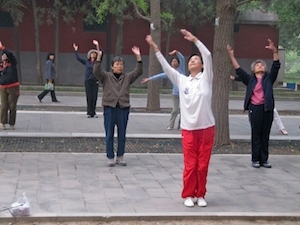
Forms can be performed lying down, sitting, standing and walking. Lying down Qigong methods can be used either for the very ill or for those who want to broaden their practice to include the periods just before sleep and just after awakening. Lying down Qigong was developed even further for those who wish to try to extend their practice into directed dreaming as did the famous Daoist Monk Chen Tuan at the Jade Spring Monastery near beautiful Flower Mountain in central China.
This overview should help you to make some sense out of the many forms around. Imagine that all of the Qigong methods are stars scattered throughout the heaven in what at first appears to be a random way. Look again, as you observe carefully over time the random stars appear to cluster together. I think that you will be inspired to find that the 10,000 forms arrange themselves into constellations.
Many forms of Qigong, particularly medical Qigong, are very practical and named for their intent – Vitality Method, Muscle and Tendon Method, Back and Spine Enhancing Method, Cancer Recovery Method. Some Qigong forms are named for cosmic qualities. Many Qigong forms are named Primordial (Wuji) and describe that pristine, primordial state of the universe, before the Big Bang, which caused Yin/Yang to arise. The essence of Qigong is the Qigong “state,” in which the Qi channels are open and circulating, inner resistance is at a minimum and the mechanism and spirit of the being are maximizing and operating optimally.
The Map
As you move toward greater understanding of Qigong it becomes quickly obvious that the body of knowledge is immense. And yet it is claimed that it is easy to learn and practice these health enhancement and self-healing arts. The best path is to work with an approach that you find interesting and fun. As always in finding and following a path, it is useful to have a map, this information will help you to get your bearings.
The Roots and Traditions of Qigong
The soil into which Qigong extends it roots is deep and rich. The most ancient roots penetrate beyond history into mysterious and legendary times. More recent forms, though still antique are historic and associated with specific traditions. There are many innovative contemporary forms as well. From its ancient and historic roots Qigong flowers as numerous bountiful traditions –Daoist, Buddhist, fitness and longevity, medical and martial.
The Roots
Legendary or ancient – Historic – Contemporary
The ancient legendary forms and methods of Qigong arise from prehistory, before writing and record keeping began. In The Pace of Yu, Shaman Yu practiced walking or dancing the pattern of the stars onto the ground. Shamanic interpretations of animals and the forces of nature were common to all original cultures. In China some of these evolved into early Qigong forms.
The roots of the historic forms, those that can be traced to their actual origination, are still typically linked to the ancient and legendary. In Zhuangzi, traces the cultivation practices from his own era to another legendary shaman from ancient time who, as the legend goes, lived to 800 years of age. “To pant, to puff, to hail, to spit out the old breath and draw in the new, practicing bear hangings and bird stretchings, longevity the only concern. Such is the life favoured by the scholar who practices Dao Yin, the man who nourishes his body with the hope of living as old as Pengzu.” Zhangzi uses the earliest name for Qigong, Dao Yin, meaning to guide and direct Qi.
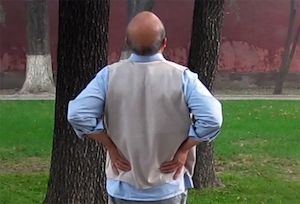
The transition to historic forms of Qigong came with the earliest detailed writings that teach Dao Yin in the Han Dynasty era, 206 BCE – 220 CE. The Dao Yin Jing, one of the original Qigong texts, was among the scrolls of the library of Master Ge Hong from the 4th century CE, a great Qi cultivation master that I have quoted a number of times. In 1972, one of the most spectacular archealogical finds in the historic era of Qigong occurred. In a group of tombs from the Han Dynasty at Ma Wang Dui a silk scroll was discovered with 40 detailed figures in an array of Dao Yin postures.
Hua To’s Animal Play, a set of practices that express the Qi of the tiger, deer, bear, monkey and crane date back to the 1st century.
The Tendon Changing and the Marrow Washing forms were originally developed by Bodhidharma who came to the Shaolin Temple and taught the monks a number of Qigong forms.
Contemporary Forms
Contemporary forms of Qigong have their roots in the forms that come before them. Guo Lin’s Cancer Recovery Walking Qigong, developed in the 1970s, has roots in the teachings of her grandfather. Universal Intelligence Qigong, from a huge Qigong hospital in the mountains east of Beijing and attributed to Dr. Pang Ming is an immensely popular contemporary form. The standing method from the hospital in Hangzhou is a contemporary version of the standing forms from earlier eras. Spontaneous Qigong is probably the most ancient Qigong, it is formless and was probably first done by humans who could not even speak an organized language somewhere around 60,000 years ago. And yet it is very contemporary due to its very personal nature.
The Tradition
Fitness, Longevity and Prevention
Medical – Daoist – Buddhist – Martial
Probably the richest way to look at the kinds of Qigong is from the perspective of the traditions. The stories that can be told, particularly of the Daoist, Buddhist and Martial traditions are part of why Qigong is so fascinating. Besides the beautiful links to nature and the universe, the eloquence and poetry of Qigong comes from the extraordinary stories of wandering Daoist monks, compassionate Buddhist Masters and the fighters who used Qi rather than muscle power to defend Emperors, court ladies, ministers and even, in certain eras, to dis-empower unethical dynasties.
Fitness and Health
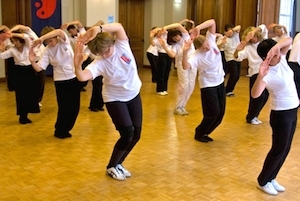
Qigong for fitness, longevity and disease prevention is the ideal in modern China. The billions of people could, if unhealthy, create a terrible health crisis. The national health system encourages people to sustain their health by using Qigong. The quest for healthy longevity is traditional in China. Qigong also aims for performance, productivity and effectiveness enhancement by addressing the health and function of those who are relatively well, including athletes, scholars and business people. At a more ultimate level, Qigong helps to create healthy, happy and compassionate people.
Medical Qigong
Medical Qigong is typically practiced by patients who work with special physicians who prescribe specific Qigong methods for specific medical conditions, consistent with the diagnosis of Qi deficiency or Qi stagnation. A person with deficiency of kidney Yang leading to cold extremities and fatigue would be prescribed a completely different practice than a person with stagnant liver Qi. However, general Qigong practices that are used in hospitals and clinics and any form of Qigong that is targeted at resolving medical challenges is considered by many to be medical Qigong. Medical Qigong also includes Qi emission healing or clinical treatment.
Daoist Qigong
Daoist Qigong is the most ancient Chinese framework for intentfully perceiving the multi-dimensional nature of the world. The health or healing gained from one’s practice is a side effect of exploring one’s relationship with the essence of nature. Daoist Qigong operates on the premise that we are given a body in this life and there is significant value in honoring and caring for it.
Buddhist Qigong
Buddhist Qigong merges the foundations of Buddhist philosophy and religion with Daoism. When Buddhism arrived in China it was immediately embraced because so much of it is consistent with the Daoist thinking that is indigenous to the Chinese culture. There are some differences between the two, however. Daoists do Qigong to honor the spirit by the filling the vessel with vitality, attaining a clear and undisturbed mind and merging with The One. Buddhists tend to discount the body and even the mind, which are considered to be illusions — distractions from ultimate reality which is pure emptiness.
Martial Qigong
Martial Qigong is the aspect of the martial arts associated with accelerating or maximizing fighting (or sport) strength to engage in any challenge, physical or mental, empowered by the Qi. The great Daoist temples – White Cloud, Dragon-Tiger, Jade Spring as well as the great Buddhist temples – Souls’s Retreat, Shaolin, Nine Flowers were all called upon at many points in China’s tumultuous history to produce monks with the highest spiritual training and values who, because of their cultivation of the invisible forces of Heaven and Earth, had radical fighting powers. This created the extremely unique Chinese tradition of Daoist and Buddhist monk warriors who were also compassionate monk healers. The martial artist with the greatest skill brings Qi cultivation to the conflict.
The highest value in this context is conflict resolution, achieved with no violence. This innovation of spiritual warriors from China is one of the great contributions of the Chinese Qi community to the world. The same Qi that makes the warrior mighty is the Qi of healing. The greatest victor is the martial expert who solves the conflict without use of martial force. Obviously, there were times when the conflict was resolved by terrible violence, but this framework of bringing peace of mind and highest spiritual values to bear on disputes will have a positive effect on conflict resolution in contemporary time as the arts of Qi cultivation become more known outside of China.
The Body in Qigong
One of the easiest ways to describe the kind of Qigong being practiced is to describe the body component. A method with Buddhist or Daoist roots may appear indistinguishable to all but the most informed eye, but the difference between a method done in the lying posture is very clearly different from a method done sitting or standing, or walking.
Lying Qigong:
- With breath focus and meditation
- With self-administered massage or postural adjustments
- With gentle movement
Sitting Qigong:
- Meditation
- With massage
- With movement
Standing Qigong
- Meditation in stillness
- With gentle movement
- With massage
Walking Qigong
- Gentle movement
- Dynamic movement
Most of these categories are obvious. Gentle movement while in the lying posture means to move the hands, feet, fingers, and toes or to shift the posture while lying down. Just prior to sleep and just after awakening are perfect times to do Lying Qigong. One of the most innovative features of Qigong is that it is easily adapted for those who are recovering from surgery or experiencing severe illness, even those who are unable to get out of bed.
Sitting Qigong is really any meditation in the Chinese tradition, or from any other tradition, whether sitting in a chair or cross-legged. Unique to the Chinese tradition are sitting and moving forms. The Silken Sitting Form starts with two relatively simple forms called Blooming of Spring and Lighting the Back Burning Spaces (associated with the Gate of Life). Then in one of the most beautiful forms I have ever seen, The Ascending Dragon, the practitioner goes from sitting to standing.
Standing Qigong is probably the most common. Standing in stillness, like the practice in a hospital in Hangzhou is a classic Qigong meditation, totally unknown in the Western world. Most Qigong is from the category of standing with movement. Standing builds strength and endurance.
Walking Qigong is any form where the practitioner advances or steps back. The Cancer Recovery Walking Qigong we explored under the “contemporary” forms is one of the easiest forms of Qigong to grasp and use. This is excellent because people with cancer need powerful tools that are easy to use. Research has proven that the method developed by Guo Lin is also very effective for many other disorders including diabetes. One of my favorite forms of walking Qigong is the Wild Goose (Dayan Gong). In it you “become” a wild goose, the bird revered by the Chinese to fly the highest and which has the most direct experience of touching Heaven and collecting the Qi of Heaven.
Massage can play a role in each of these. Self-administered massage, to muscle groups or pressure points along with patting and even gentle pounding, is frequently included in Qigong. Anything that enhances, refines and cultivates the Qi is Qigong. Massage is a key feature of most Qigong systems.
Dynamic, Form and Focus in Qigong
The dynamic of Qigong reveals the huge difference between absolute stillness which is Yin and extreme movement, Yang. Specific and directed Qigong forms cultivate Qi in a completely different context than purely spontaneous and formless methods. An almost separate universe of Qigong emerges in the context of the external focus of Qigong.
The Dynamic of Qigong
Quiescent – Dynamic – Vigorous
One of the highest priorities in Qigong is deep relaxation and a purposeful freeing of the nervous system and inner function from the effects of tension. When one elects to enter the Qigong state, whether during a Qigong practice session or anytime throughout the day, posture and breath are important, but it is the state of clear minded relaxation that has the most power to pull you into the Qigong state. Most Qigong forms are relatively Quiescent, allowing for the decrease of inner resistance and maximum flow.
It is not impossible to attain the Qigong state in dynamic or vigorous practices. There are cleansing or purifying methods that are more vigorous with the intention of expelling spent or extra Qi. And some practices are more vigorous to activate the Qi and increase the circulation including the Qigong Warm-Ups that we will learn at the end of this chapter
While all forms of Qigong are meditations, the quiescent forms are the closest to what we usually associate with meditation. In lying, sitting, and standing Qigong there can be absolute stillness or there can be movement. In quiescent Qigong – lying, sitting or standing – there is only stillness.
According to an ancient proverb, “The more you focus on movement outside, the less you can focus on movement inside.” When you place your attention on external movement, Qi and inner resources are busy attending to the function of the muscles and the metabolism of “doing”. When the mind is externally focused the preferred state of inner directed, clear and neutral mind is less attainable.
Martial arts almost always include meditation practices. The meditation is Yin, the vigorous martial arts methods are Yang and the two together foster balance and harmony of the body, mind and spirit. And this is the reason that so many forms of Qigong are mildly dynamic, that is neither completely quiescent nor wildly vigorous. Such forms inherently harmonize Yin and Yang within one method. All forms of Tai Chi are mildly dynamic and carefully balanced — allowing mind clearing, meditation and relaxation to occur simultaneously with gentle movement. This is probably the most important innovation of Qigong because it allows for the healing and empowering effects of both meditation and gentle movement to act synergistically.
The Form
Form – specific, directed, formalized
No form – spontaneous, formless, non-specific, intuitive
While some types of Qigong, like Quiescent lying and sitting Qigong, are relatively formless, the words “Qi Gong Form” (Qigong Feng Fa) usually describe the actual physical movements in a dynamic or vigorous Qigong method or technique. One of the most provocative and eloquent components of Qigong is that the forms frequently have beautiful poetic and philosophical names that deepen their meaning.
Some Qigong forms are brief and simple and easy to learn practice and teach. For example, in the Flowing Motion which is a classic, used by millions of people in China you simply start in the Preliminary Standing Posture that we learned with the Qigong Opening. On the inhalation, with arms at your side, you swing the arms forward and upward slowly on the inhalation, until at about the level of your eyes. On the exhalation you allow the arms to drift back down, gently. You may repeat a few or many times. I have heard now from many people who love the idea that simply doing 100 repetitions of the Flowing Motion is reputed in China as a way to “be healthy for the rest of your life”. In fact, it is said that if you do a thousand of the Flowing Method you will become immortal. Most people understand that, to the Chinese, this means you will gain access to your universal and eternal self.
Whilst some forms are very long most can be broken down into smaller components for ease of learning and practice.
Spontaneous or Formless Qigong
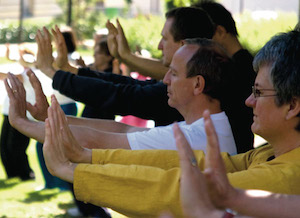
Spontaneous or Formless Qigong is particularly fascinating because there is nothing to learn and nothing to follow. Natural Flow Qigong is formless Qigong. Quiescent Qigong meditation where there is no external movement is formless as there are no external movements to learn and practice. Methods that include body movement, but are not directed, specific and formalized, are also formless. We visited the hospital in Hangzhou where both approaches were used. First there was a standing meditation that was completely internalized and formless. That was followed by Spontaneous Qigong, which included movement but is formless, spontaneous and intuitive.
The very simple nature of formless Qigong makes it particularly accessible to people who feel uncoordinated or don’t believe they have the time to grasp Qigong forms. The difference between a beginner and someone with lots of experience in formless Qigong is invisible. When I lead classes or practices in formless Qigong people always comment that it was their favorite part. This is because it is so very simple and yet very deep. With the formless method you can work the Qi into the deepest places where it is needed, the way water finds its way deep into the ground.
Spontaneous Qigong is sometimes called Wuji Qigong or Dancing in Primordial Chaos because each practitioner tunes in to their own pre-birth nature — their pre-natal, primordial or original state — beyond personal conditioning and local personality. It is believed that while you may be unwell or challenged in your present personal situation, you are already healed and supremely well in your universal self – the Spirit (Shen). Dancing in Chaos can also be called Shen Qigong, a method for accessing the ultimate and essential perfection of the universal self (Shen). In this formless method the practitioner channels or absorbs their Shen, their universal nature, purposefully into the body/mind of the local self. This primordial potential is collected in the Qi channels and Elixir Fields (Dan Tian) to enhance the present condition. Eventually it becomes clear that the primordial self — the already perfect version of the self — is latent within. Wuji Qigong at this point becomes less focused on collecting something from outside and more on revealing what is already buried within — perfect health, intuition and insight, productivity, creativity and inner peace.
Many know that the highest Qigong attainment is impossible to teach, because the most advanced methods are formless. The most advanced Qigong comes from direct experience of the true nature of Qi, one’s eternal nature and the Universe itself.
The Focus
Internal Qigong – Neigong
External Qigong – Waigong
Ancient philosophical traditions are often somewhat paradoxical, and so too can be the concepts of internal and external focus in Qigong and Tai Chi. Let’s try to keep it simple. Internal refers to that which is always within you. However, external can mean two completely different things. Understanding this will make many discussions and written resources more clear to you, particularly those that refer to external Qigong. For some this discussion will be useful and clarifying, others may find it confusing. If such detail pulls you out of the Qigong state, turn to the practice of Natural Flow Qigong. This can help to engage that inner state of flow. You can come back to these ideas another time.
Internal Qigong simply means that the focus of the practice lies within you. All forms of Qigong, from Tai Chi to the thousands of health improvement Qigong techniques practiced in the parks and hospitals in China, are types of internal practice. Deeper or more advanced internal practices usually refer to Qigong methods that are called Inner Alchemy (Nei Dan) and are focused beyond health improvement on the domain of spiritual transformation — as in the Heaven Phases we will be exploring in Part II.
External Qigong, particularly when used to describe the focus of one’s personal practice usually means that the methods include movement of the muscles and extremities. Given the internal self is represented by the organs, fluids and the merging of Heaven and Earth in the HeartMind, the extremities and muscles are relatively external. Martial arts practices, which often have a Qi cultivation component, are primarily externally focused – on expressing the power of the Qi in the muscles and extremities. But the paradox of Qigong is that an external form of Qi cultivation, the martial arts for example, can have an internal component as well, in this case Kung Fu. And the most paradoxical — Tai Chi is considered to be an internal form of martial art, but a relatively external form of Qigong.
Many forms of Qigong are considered external because they focus on external body movement, bodily health and building strength and flexibility of the limbs. Internal Qigong typically focuses on more quiescent body methods (less external movement) along with mind and spirit — not only tor healing and longevity but to enhance wisdom and insight as well. Both internal and external become relative when the martial aspect of the Chinese disciplines are discussed. You could say that internally focused martial arts are usually somewhere near equivalent to externally focused Qigong.
There is one additional aspect of external Qigong, however, that is one of the most fascinating aspects of Qi cultivation.
Qi Transmission Healing
External Qi Healing (Wai Qigong), describes a practice of Qigong where a practitioner transmits or channels Qi to help or treat another. Qi is invisible and difficult to explain or categorize scientifically. As a result, external Qigong based in transmitting healing influence to others is somewhat controversial. However, as you will discover in The Light of Science on Qi, we are rapidly gaining a better understanding of what the Chinese ancients discovered in research on what is now called non-local or distant healing. There is wide variety of such distant healing methodologies based on Qi, Prana, magnetic energy and consciousness including Therapeutic Touch, Healing Touch, Reiki, Prana Healing, Polarity Therapy, SHEN Therapy as well as Qigong Healing and prayer. Many, many people have derived powerful health enhancement and dramatic healing from such modalities.
One of the important differences between Qigong healing and many of the other forms of distant healing is that Qigong inherently includes an entire system of personal practice – internal Qigong — to complement the healing from a practitioner.
Also recommended on Qigong
Qigong Excercises
Health Qigong
Spiritual Qigong
Medical Qigong
Free PDF-Download: “Taiji Qigong 18 Exercises“, “5_Animal_Qigong” and “Seasonal Qigong“
Author: Roger Jahnke
Images: Taiji-Europa, Ronnie Robinson and Roger Jahnke

